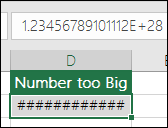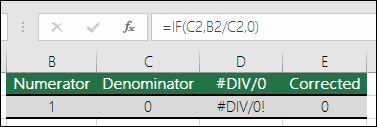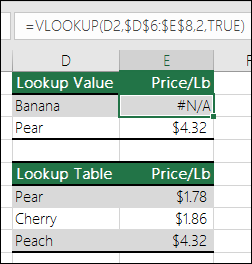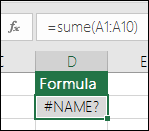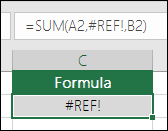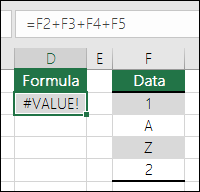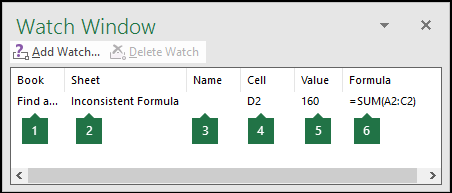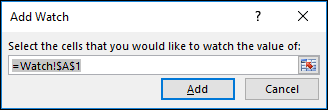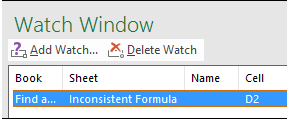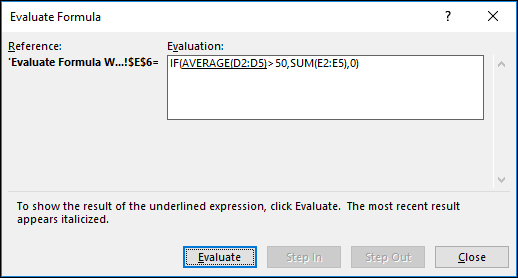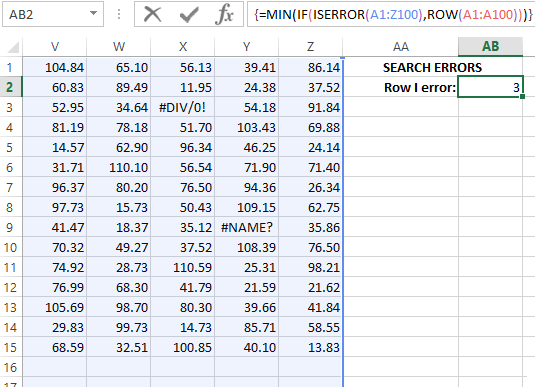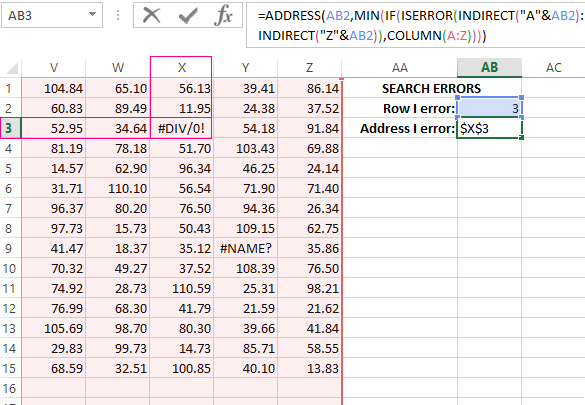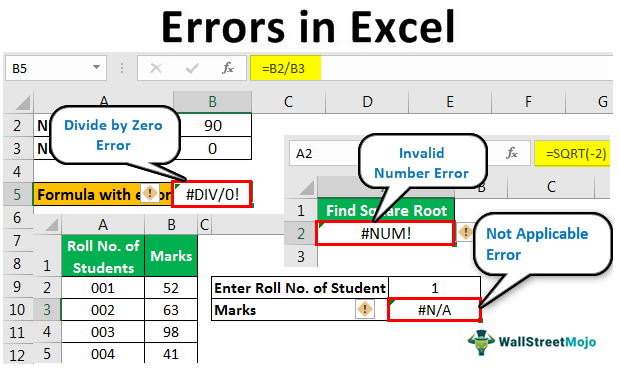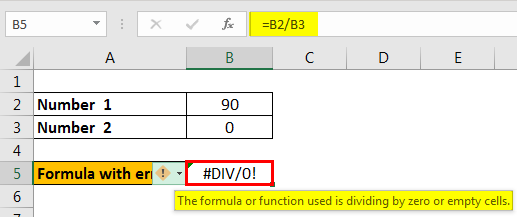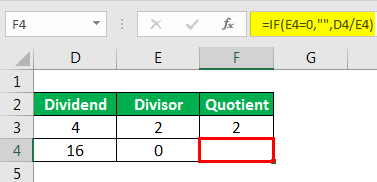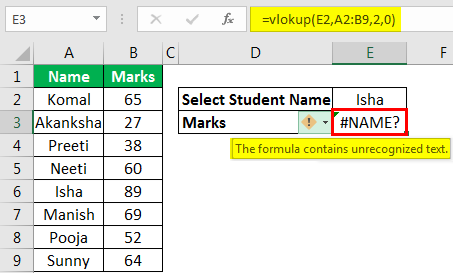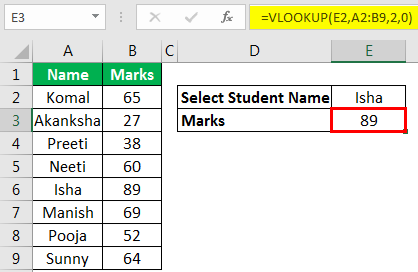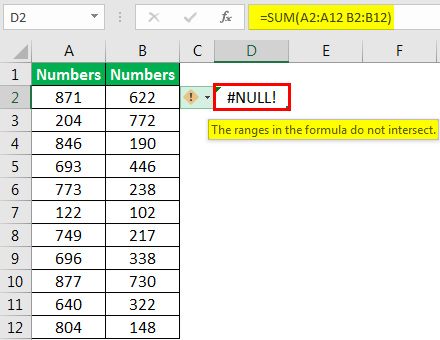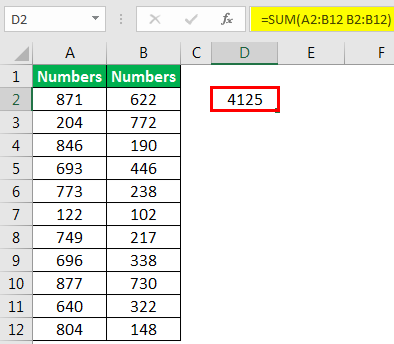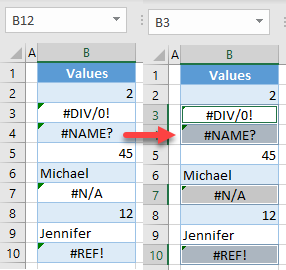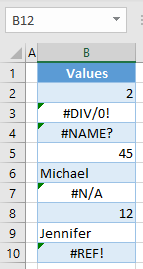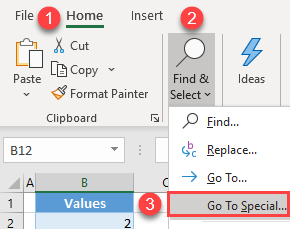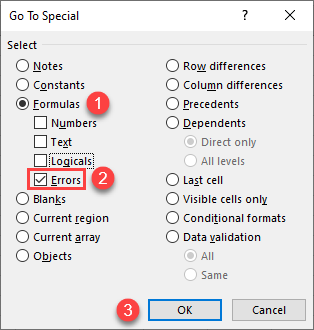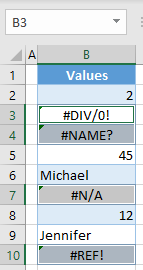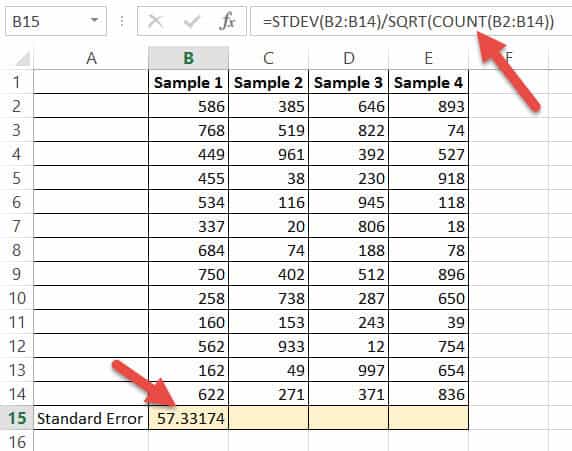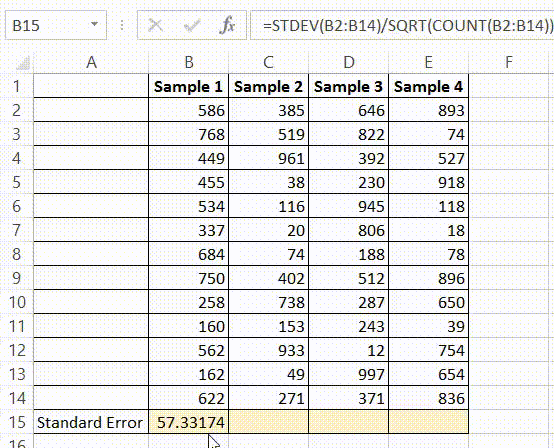Errors are quite common. You will not find a single person who does not make any errors in Excel. When the errors are part and parcel of Excel, one must know how to find those errors and resolve those issues.
When using Excel routinely, we may encounter many errors flagged if the error handler is enabled. Otherwise, we may get potential calculation errors. So if you are new to error handling in Excel, this article is a perfect guide for you.
Table of contents
- How to Find Errors in Excel?
- Find and Handle Errors in Excel
- Example #1 – Error Handling through Error Handler
- Example #2 – Formulas Error Handling
- Things to Remember
- Recommended Articles
- Find and Handle Errors in Excel
Find and Handle Errors in Excel
You can download this Error Checking Excel Template here – Error Checking Excel Template
Whenever an Excel cell encounters an error, it will, by default, display the error through the error handler. The error handler in Excel is a built-in tool. We can enable this using this and get the full benefit of it.
As we can see in the above image, we have an error notifier showing that there is an error with the cell B2 value.
You also must have come across this error handler in Excel but are not aware of this. If the Excel worksheet does not show this error handling message, we must enable this by following the below steps:
- We must first click on the “File” tab in the ribbon.
- Under the “File” tab, click on “Options.”
- It will open the “Excel Options” window. Next, click on the “Formulas” tab.
- Under “Error Checking,” check the “Enable background error checking” box.
At the bottom, we can choose the color which can notify the error. The green color has been selected by default, but we can change this.
Example #1 – Error Handling through Error Handler
When the data format is not proper, we may get errors. So in those scenarios, in that particular cell, we may see that error notification.
- For example, look at the below image of an error.
When we place our cursor on that error handler, it shows the message, “The number in this cell is formatted as text or preceded by an apostrophe.”
- To fix this error, we must click on the drop-down listA drop-down list in excel is a pre-defined list of inputs that allows users to select an option.read more of the icon, and we see the below options.
- The first displays “Number Stored as Text,” which is the error. To fix this excel errorErrors in excel are common and often occur at times of applying formulas. The list of nine most common excel errors are — #DIV/0, #N/A, #NAME?, #NULL!, #NUM!, #REF!, #VALUE!, #####, Circular Reference.read more, look at the second option. The “Convert to Number” mentions clicking on these options. Therefore, it will solve the error.
Now, look at the cell. It has no error message icon now. Like this, we can fix data format-related errors easily.
Example #2 – Formulas Error Handling
Formulas often return an error. To deal with those errors, we need to employ a different strategy. Before handling the error, we need to look at the kind of errors we encounter in different scenarios.
Below are the kind of errors we see in Excel.
- #DIV/0! – If the number is divided by 0 or an empty cell, we may get the #DIV/0 error#DIV/0! is the division error in Excel which occurs every time a number is divided by zero. Simply put, we get this error when we divide any number by an empty or zero-value cell.read more.
- #N/A – If the VLOOKUP formula does not find a value, then we get this error.
- #NAME? – If the formula name is not recognized, we get this error.
- #REF! – When the formula reference cell is deleted, or the formula reference area is out of range, we may get this #REF! Error.
- #VALUE! – When wrong data types are included in the formula, we may get the #VALUE! Error#VALUE! Error in Excel represents that the reference cell the user has either entered an incorrect formula or used a wrong data type (mostly numerical data). Sometimes, it is difficult to identify the kind of mistake behind this error.read more.
So, to deal with the above error values, we need to use the IFERROR functionThe IFERROR function in Excel checks a formula (or a cell) for errors and returns a specified value in place of the error.read more.
- For example, look at the below formula image.
The VLOOKUP formula has been applied. However, the LOOKUP value “8” is not mentioned in the “Table Array” range A2 to B6, so the VLOOKUP returns an error value as #N/A, i.e., not available error.
- To fix this error, we must use the IFERROR function.
Before using the VLOOKUP function, we used the IFERROR function. If the VLOOKUP function returns an error instead of a result, the IFERROR function returns the alternative outcome, “Not Available,” instead of the traditional #N/A error result.
Like this, we can handle errors in Excel.
Things to Remember
- The error notifier will show an error icon if the cell value data type is unsuitable.
- The IFERROR function is typically used to check formula errors.
Recommended Articles
This article is a guide to Finding Errors in Excel. Here, we discuss finding and handling errors in Excel, practical examples, and a downloadable Excel template. You may learn more about financing from the following articles: –
- Error Bars in Excel
- Formula Errors in Excel
- IFERROR with VLOOKUP in Excel
- Excel Test
Excel for Microsoft 365 Excel for Microsoft 365 for Mac Excel 2021 Excel 2021 for Mac Excel 2019 Excel 2019 for Mac Excel 2016 Excel 2016 for Mac Excel 2013 Excel 2010 Excel 2007 Excel for Mac 2011 Excel Starter 2010 More…Less
Formulas can sometimes result in error values in addition to returning unintended results. The following are some tools that you can use to find and investigate the causes of these errors and determine solutions.
Note: This topic contains techniques that can help you correct formula errors. It is not an exhaustive list of methods for correcting every possible formula error. For help on specific errors, you can search for questions like yours in the Excel Community Forum, or post one of your own.
Learn how to enter a simple formula
Formulas are equations that perform calculations on values in your worksheet. A formula starts with an equal sign (=). For example, the following formula adds 3 to 1.
=3+1
A formula can also contain any or all of the following: functions, references, operators, and constants.
Parts of a formula
-
Functions: included with Excel, functions are engineered formulas that carry out specific calculations. For example, the PI() function returns the value of pi: 3.142…
-
References: refer to individual cells or ranges of cells. A2 returns the value in cell A2.
-
Constants: numbers or text values entered directly into a formula, such as 2.
-
Operators: The ^ (caret) operator raises a number to a power, and the * (asterisk) operator multiplies. Use + and – add and subtract values, and / to divide.
Note: Some functions require what are referred to as arguments. Arguments are the values that certain functions use to perform their calculations. When required, arguments are placed between the function’s parentheses (). The PI function does not require any arguments, which is why it’s blank. Some functions require one or more arguments, and can leave room for additional arguments. You need to use a comma to separate arguments, or a semi-colon (;) depending on your location settings.
The SUM function for example, requires only one argument, but can accommodate 255 total arguments.
=SUM(A1:A10) is an example of a single argument.
=SUM(A1:A10, C1:C10) is an example of multiple arguments.
The following table summarizes some of the most common errors that a user can make when entering a formula, and explains how to correct them.
|
Make sure that you |
More information |
|
Start every function with the equal sign (=) |
If you omit the equal sign, what you type may be displayed as text or as a date. For example, if you type SUM(A1:A10), Excel displays the text string SUM(A1:A10) and does not perform the calculation. If you type 11/2, Excel displays the date 2-Nov (assuming the cell format is General) instead of dividing 11 by 2. |
|
Match all open and closing parentheses |
Make sure that all parentheses are part of a matching pair (opening and closing). When you use a function in a formula, it is important for each parenthesis to be in its correct position for the function to work correctly. For example, the formula =IF(B5<0),»Not valid»,B5*1.05) will not work because there are two closing parentheses and only one open parenthesis, when there should only be one each. The formula should look like this: =IF(B5<0,»Not valid»,B5*1.05). |
|
Use a colon to indicate a range |
When you refer to a range of cells, use a colon (:) to separate the reference to the first cell in the range and the reference to the last cell in the range. For example, =SUM(A1:A5), not =SUM(A1 A5), which would return a #NULL! Error. |
|
Enter all required arguments |
Some functions have required arguments. Also, make sure that you have not entered too many arguments. |
|
Enter the correct type of arguments |
Some functions, such as SUM, require numerical arguments. Other functions, such as REPLACE, require a text value for at least one of their arguments. If you use the wrong type of data as an argument, Excel may return unexpected results or display an error. |
|
Nest no more than 64 functions |
You can enter, or nest, no more than 64 levels of functions within a function. |
|
Enclose other sheet names in single quotation marks |
If a formula refers to values or cells on other worksheets or workbooks, and the name of the other workbook or worksheet contains spaces or non-alphabetical characters, you must enclose its name within single quotation marks ( ‘ ), like =’Quarterly Data’!D3, or =‘123’!A1. |
|
Place an exclamation point (!) after a worksheet name when you refer to it in a formula |
For example, to return the value from cell D3 in a worksheet named Quarterly Data in the same workbook, use this formula: =’Quarterly Data’!D3. |
|
Include the path to external workbooks |
Make sure that each external reference contains a workbook name and the path to the workbook. A reference to a workbook includes the name of the workbook and must be enclosed in brackets ([Workbookname.xlsx]). The reference must also contain the name of the worksheet in the workbook. If the workbook that you want to refer to is not open in Excel, you can still include a reference to it in a formula. You provide the full path to the file, such as in the following example: =ROWS(‘C:My Documents[Q2 Operations.xlsx]Sales’!A1:A8). This formula returns the number of rows in the range that includes cells A1 through A8 in the other workbook (8). Note: If the full path contains space characters, as does the preceding example, you must enclose the path in single quotation marks (at the beginning of the path and after the name of the worksheet, before the exclamation point). |
|
Enter numbers without formatting |
Do not format numbers when you enter them in formulas. For example, if the value that you want to enter is $1,000, enter 1000 in the formula. If you enter a comma as part of a number, Excel treats it as a separator character. If you want numbers displayed so that they show thousands or millions separators, or currency symbols, format the cells after you enter the numbers. For example, if you want to add 3100 to the value in cell A3, and you enter the formula =SUM(3,100,A3), Excel adds the numbers 3 and 100 and then adds that total to the value from A3, instead of adding 3100 to A3 which would be =SUM(3100,A3). Or, if you enter the formula =ABS(-2,134), Excel displays an error because the ABS function accepts only one argument: =ABS(-2134). |
You can implement certain rules to check for errors in formulas. These rules do not guarantee that your worksheet is error free, but they can go a long way toward finding common mistakes. You can turn any of these rules on or off individually.
Errors can be marked and corrected in two ways: one error at a time (like a spell checker), or immediately when they occur on the worksheet as you enter data.
You can resolve an error by using the options that Excel displays, or you can ignore the error by clicking Ignore Error. If you ignore an error in a particular cell, the error in that cell does not appear in further error checks. However, you can reset all previously ignored errors so that they appear again.
-
For Excel on Windows, Click File > Options > Formulas, or
for Excel on Mac, click the Excel menu > Preferences > Error Checking.In Excel 2007, click the Microsoft Office button
> Excel Options > Formulas.
-
Under Error Checking, check Enable background error checking. Any error that is found, will be marked with a triangle in the top-left corner of the cell.
-
To change the color of the triangle that marks where an error occurs, in the Indicate errors using this color box, select the color that you want.
-
Under Excel checking rules, select or clear the check boxes of any of the following rules:
-
Cells containing formulas that result in an error: A formula does not use the expected syntax, arguments, or data types. Error values include #DIV/0!, #N/A, #NAME?, #NULL!, #NUM!, #REF!, and #VALUE!. Each of these error values have different causes and are resolved in different ways.
Note: If you enter an error value directly in a cell, it is stored as that error value but is not marked as an error. However, if a formula in another cell refers to that cell, the formula returns the error value from that cell.
-
Inconsistent calculated column formula in tables: A calculated column can include individual formulas that are different from the master column formula, which creates an exception. Calculated column exceptions are created when you do any of the following:
-
Type data other than a formula in a calculated column cell.
-
Type a formula in a calculated column cell, and then use Ctrl +Z or click Undo
on the Quick Access Toolbar.
-
Type a new formula in a calculated column that already contains one or more exceptions.
-
Copy data into the calculated column that does not match the calculated column formula. If the copied data contains a formula, this formula overwrites the data in the calculated column.
-
Move or delete a cell on another worksheet area that is referenced by one of the rows in a calculated column.
-
-
Cells containing years represented as 2 digits: The cell contains a text date that can be misinterpreted as the wrong century when it is used in formulas. For example, the date in the formula =YEAR(«1/1/31») could be 1931 or 2031. Use this rule to check for ambiguous text dates.
-
Numbers formatted as text or preceded by an apostrophe: The cell contains numbers stored as text. This typically occurs when data is imported from other sources. Numbers that are stored as text can cause unexpected sorting results, so it is best to convert them to numbers. ‘=SUM(A1:A10) is seen as text.
-
Formulas inconsistent with other formulas in the region: The formula does not match the pattern of other formulas near it. In many cases, formulas that are adjacent to other formulas differ only in the references used. In the following example of four adjacent formulas, Excel displays an error next to the formula =SUM(A10:C10) in cell D4 because the adjacent formulas increment by one row, and that one increments by 8 rows — Excel expects the formula =SUM(A4:C4).
If the references that are used in a formula are not consistent with those in the adjacent formulas, Excel displays an error.
-
Formulas which omit cells in a region: A formula may not automatically include references to data that you insert between the original range of data and the cell that contains the formula. This rule compares the reference in a formula against the actual range of cells that is adjacent to the cell that contains the formula. If the adjacent cells contain additional values and are not blank, Excel displays an error next to the formula.
For example, Excel inserts an error next to the formula =SUM(D2:D4) when this rule is applied, because cells D5, D6, and D7 are adjacent to the cells that are referenced in the formula and the cell that contains the formula (D8), and those cells contain data that should have been referenced in the formula.
-
Unlocked cells containing formulas: The formula is not locked for protection. By default, all cells on a worksheet are locked so they can’t be changed when the worksheet is protected. This can help avoid inadvertent mistakes like accidentally deleting or altering formulas. This error indicates that the cell has been set to be unlocked, but the sheet has not been protected. Check to make sure that you do not want the cell locked or not.
-
Formulas referring to empty cells: The formula contains a reference to an empty cell. This can cause unintended results, as shown in the following example.
Suppose you want to calculate the average of the numbers in the following column of cells. If the third cell is blank, it is not included in the calculation and the result is 22.75. If the third cell contains 0, the result is 18.2.
-
Data entered in a table is invalid: There is a validation error in a table. Check the validation setting for the cell by going to the Data tab > Data Tools group > Data Validation.
-
-
Select the worksheet you want to check for errors.
-
If the worksheet is manually calculated, press F9 to recalculate.
If the Error Checking dialog is not displayed, then click on the Formulas tab > Formula Auditing > Error Checking button.
-
If you have previously ignored any errors, you can check for those errors again by doing the following: click File > Options > Formulas. For Excel on Mac, click the Excel menu > Preferences > Error Checking.
In the Error Checking section, click Reset Ignored Errors > OK.
Note: Resetting ignored errors resets all errors in all sheets in the active workbook.
Tip: It might help if you move the Error Checking dialog box just below the formula bar.
-
Click one of the action buttons in the right side of the dialog box. The available actions differ for each type of error.
-
Click Next.
Note: If you click Ignore Error, the error is marked to be ignored for each consecutive check.
-
Next to the cell, click the Error Checking button
that appears, and then click the option you want. The available commands differ for each type of error, and the first entry describes the error.
If you click Ignore Error, the error is marked to be ignored for each consecutive check.
If a formula cannot correctly evaluate a result, Excel displays an error value, such as #####, #DIV/0!, #N/A, #NAME?, #NULL!, #NUM!, #REF!, and #VALUE!. Each error type has different causes, and different solutions.
The following table contains links to articles that describe these errors in detail, and a brief description to get you started.
|
Topic |
Description |
|
Correct a #### error |
Excel displays this error when a column is not wide enough to display all the characters in a cell, or a cell contains negative date or time values. For example, a formula that subtracts a date in the future from a date in the past, such as =06/15/2008-07/01/2008, results in a negative date value. Tip: Try to auto-fit the cell by double-clicking between the column headers. If ### is displayed because Excel can’t display all of the characters this will correct it. |
|
Correct a #DIV/0! error |
Excel displays this error when a number is divided either by zero (0) or by a cell that contains no value. Tip: Add an error handler like in the following example, which is =IF(C2,B2/C2,0) |
|
Correct a #N/A error |
Excel displays this error when a value is not available to a function or formula. If you’re using a function like VLOOKUP, does what you’re trying to lookup have a match in the lookup range? Most often it doesn’t. Try using IFERROR to suppress the #N/A. In this case you could use: =IFERROR(VLOOKUP(D2,$D$6:$E$8,2,TRUE),0) |
|
Correct a #NAME? error |
This error is displayed when Excel does not recognize text in a formula. For example, a range name or the name of a function may be spelled incorrectly. Note: If you’re using a function, make sure the function name is spelled correctly. In this case SUM is spelled incorrectly. Remove the “e” and Excel will correct it. |
|
Correct a #NULL! error |
Excel displays this error when you specify an intersection of two areas that do not intersect (cross). The intersection operator is a space character that separates references in a formula. Note: Make sure your ranges are correctly separated — the areas C2:C3 and E4:E6 do not intersect, so entering the formula =SUM(C2:C3 E4:E6) returns the #NULL! error. Putting a comma between the C and E ranges will correct it =SUM(C2:C3,E4:E6) |
|
Correct a #NUM! error |
Excel displays this error when a formula or function contains invalid numeric values. Are you using a function that iterates, such as IRR or RATE? If so, the #NUM! error is probably because the function can’t find a result. Refer to the help topic for resolution steps. |
|
Correct a #REF! error |
Excel displays this error when a cell reference is not valid. For example, you may have deleted cells that were referred to by other formulas, or you may have pasted cells that you moved on top of cells that were referred to by other formulas. Did you accidentally delete a row or column? We deleted column B in this formula, =SUM(A2,B2,C2), and look what happened. Either use Undo (Ctrl+Z) to undo the deletion, rebuild the formula, or use a continuous range reference like this: =SUM(A2:C2), which would have automatically updated when column B was deleted. |
|
Correct a #VALUE! error |
Excel can display this error if your formula includes cells that contain different data types. Are you using Math operators (+, -, *, /, ^) with different data types? If so, try using a function instead. In this case =SUM(F2:F5) would correct the problem. |
When cells are not visible on a worksheet, you can watch those cells and their formulas in the Watch Window toolbar. The Watch Window makes it convenient to inspect, audit, or confirm formula calculations and results in large worksheets. By using the Watch Window, you don’t need to repeatedly scroll or go to different parts of your worksheet.
This toolbar can be moved or docked like any other toolbar. For example, you can dock it on the bottom of the window. The toolbar keeps track of the following cell properties: 1) Workbook, 2) Sheet, 3) Name (if the cell has a corresponding Named Range), 4) Cell address, 5) Value, and 6) Formula.
Note: You can have only one watch per cell.
Add cells to the Watch Window
-
Select the cells that you want to watch.
To select all cells on a worksheet with formulas, on the Home tab, in the Editing group, click Find & Select (or you can use Ctrl+G, or Control+G on the Mac)> Go To Special > Formulas.
-
On the Formulas tab, in the Formula Auditing group, click Watch Window.
-
Click Add Watch.
-
Confirm that you have selected all of the cells you want to watch and click Add.
-
To change the width of a Watch Window column, drag the boundary on the right side of the column heading.
-
To display the cell that an entry in Watch Window toolbar refers to, double-click the entry.
Note: Cells that have external references to other workbooks are displayed in the Watch Window toolbar only when the other workbooks are open.
Remove cells from the Watch Window
-
If the Watch Window toolbar is not displayed, on the Formulas tab, in the Formula Auditing group, click Watch Window.
-
Select the cells that you want to remove.
To select multiple cells, press CTRL and then click the cells.
-
Click Delete Watch.
Sometimes, understanding how a nested formula calculates the final result is difficult because there are several intermediate calculations and logical tests. However, by using the Evaluate Formula dialog box, you can see the different parts of a nested formula evaluated in the order the formula is calculated. For example, the formula =IF(AVERAGE(D2:D5)>50,SUM(E2:E5),0)is easier to understand when you can see the following intermediate results:
|
In the Evaluate Formula dialog box |
Description |
|
=IF(AVERAGE(D2:D5)>50,SUM(E2:E5),0) |
The nested formula is initially displayed. The AVERAGE function and the SUM function are nested within the IF function. The cell range D2:D5 contains the values 55, 35, 45, and 25, and so the result of the AVERAGE(D2:D5) function is 40. |
|
=IF(40>50,SUM(E2:E5),0) |
The cell range D2:D5 contains the values 55, 35, 45, and 25, and so the result of the AVERAGE(D2:D5) function is 40. |
|
=IF(False,SUM(E2:E5),0) |
Because 40 is not greater than 50, the expression in the first argument of the IF function (the logical_test argument) is False. The IF function returns the value of the third argument (the value_if_false argument). The SUM function is not evaluated because it is the second argument to the IF function (value_if_true argument), and it is returned only when the expression is True. |
-
Select the cell that you want to evaluate. Only one cell can be evaluated at a time.
-
Select the Formulas tab > Formula Auditing > Evaluate Formula.
-
Click Evaluate to examine the value of the underlined reference. The result of the evaluation is shown in italics.
If the underlined part of the formula is a reference to another formula, click Step In to display the other formula in the Evaluation box. Click Step Out to go back to the previous cell and formula.
The Step In button is not available for a reference the second time the reference appears in the formula, or if the formula refers to a cell in a separate workbook.
-
Continue clicking Evaluate until each part of the formula has been evaluated.
-
To see the evaluation again, click Restart.
-
To end the evaluation, click Close.
Notes:
-
Some parts of formulas that use the IF and CHOOSE functions are not evaluated — in these cases, #N/A is displayed in the Evaluation box.
-
If a reference is blank, a zero value (0) is displayed in the Evaluation box.
-
The following functions are recalculated each time the worksheet changes, and can cause the Evaluate Formula dialog box to give results different from what appears in the cell: RAND, AREAS, INDEX, OFFSET, CELL, INDIRECT, ROWS, COLUMNS, NOW, TODAY, RANDBETWEEN.
Need more help?

You can always ask an expert in the Excel Tech Community or get support in the Answers community.
See Also
Display the relationships between formulas and cells
How to avoid broken formulas
Need more help?
To save time on visual analysis of large tables in order to identify errors, it is more rationally to apply formulas for determining its location. For example, the information about the localization of the first error, that occurred relative to the rows and columns of the sheet, would be very useful.
Searching of errors in Excel by the formula
To determine of position an error location in a table with big amount of rows and columns, we recommend to take advantage of the special formula. For example we show the formula, that can easily works with large ranges of cells, within A1:Z100.
To determining to the localization of the first error on the sheet concerning of the rows, you should use to the following:
This should be executed in an array, so after entering it, you need to press to the combination of hot keys: CTRL + SHIFT + Enter. If everything is done correctly, in the formula line will be appear the curly brackets appear, as you can see in the picture.
The table with large amount of data contains to errors, the first of which is in the range of the third line of the sheet 3:3.
How to get the address of the cell with an error?
Based on the result of calculating this formula you can create to another formula that does not just define to a row or a column, but will indicate the immediate address of the error on the Excel sheet. To solve this problem below (in the cell AB 3), you need to enter to another:
This should also be executed in the array, so after entering it again, you need to press CTRL + SHIFT + Enter to confirm. The result of calculating of the local address of the cell that contains the first error in the table:
The principle of the search for error:
In the first argument of the ADDRESS function you need to specify to the line number that must be returned in the cell address, containing to the result of the action of the whole formula. The line number is defined by the previous formula and is the number 3. Therefore we only refer to the cell AB2 with the first formula. Next, using the function INDIRECT, the reference is made to the range that must be found in accordance with the location of the errors.
It is not necessary to perform to the searching on the whole table, thus loading to the processor of the computer and unnecessarily taking away the computational resources of the Excel program. We are only interested in the third line.
With helping of the ISERROR function, each of the cell in the A3:Z3 range is checked for errors. On the basis of the results obtained in an array, is created in the program memory of the logical values TRUE and FALSE. The next COLUMN function returns to the program memory to the second array of the column numbers with the numbers of elements, which corresponding to the number of columns in the range A3:Z3.
Download example find an errors in Excel
Thanks to the IF function in the first array, the logical value TRUE is replaced by the corresponding numeric value from the second array. After that, the MIN function selects the smallest numerical value of the first array, which corresponds to the number of the column, containing to the first error. Since we calculated to the row and column numbers, the calculation of the formula with the ADDRESS function is completed. It already returns by the text value for the finished cell address, which are based on the column number and the string specified in its arguments.
Содержание
- How to correct a #VALUE! error in FIND/FINDB and SEARCH/SEARCHB functions
- A few things to know about FIND and SEARCH functions
- Problem: the value in the find_text argument cannot be found in the within_text string
- Problem: The start_num argument is set to zero (0)
- Problem: The start_num argument is greater than the within_text argument
- Need more help?
- How to find an error in the Excel table according to the formula?
- Searching of errors in Excel by the formula
- How to get the address of the cell with an error?
- Errors in Excel
- List of Various Excel Errors
- Types of Errors in Excel with Examples
- 1 – #DIV/0 Error
- 2 – #N/A Error
- 3 – #NAME? Error
- 4 – #NULL! Error
- 5 – #NUM! Error
- 6 – #REF! Error
- 7 – #VALUE! Error
- 8 – ###### Error
- 9 – Circular Reference Error
- Function to Deal with Excel Errors
- 1 – ISERROR Function
- 2 – AGGREGATE Function
- Things to Remember
- Recommended Articles
How to correct a #VALUE! error in FIND/FINDB and SEARCH/SEARCHB functions
This topic provides help for the most common scenarios for the #VALUE! error in the FIND/FINDB and SEARCH/SEARCHB functions.
A few things to know about FIND and SEARCH functions
The FIND and SEARCH functions are very similar. They both work in the same way — locate a character or a text string in another text string. The difference between these two functions is that FIND is case-sensitive, and SEARCH is not case-sensitive. So if you don’t want to match case in a text string, use SEARCH.
If you want a function that returns the string based on the character number you specify, use the MID function along with FIND. You can find information and examples of using MID and FIND combinations in the FIND help topic.
The syntax of these functions is the same, find_text, within_text, [start_num]). In simple English, the syntax means What do you want to find?, Where do you want to find it?, What position do you want to start from?
Problem: the value in the find_text argument cannot be found in the within_text string
If the function cannot find the text to be found in the specified text string, it will throw a #VALUE! error.
For example, a function like:
Will throw the #VALUE! error, because there is no matching “gloves” in the string, but there is “Gloves”. Remember that FIND is case-sensitive, so make sure the value in find_text has an exact match in the string in the within_text argument.
However, this SEARCH function will return a value of 1, since it’s not case-sensitive:
Solution: Correct the syntax as necessary.
Problem: The start_num argument is set to zero (0)
The start_num argument is an optional argument, and if you omit it, the default value will be assumed to be 1. However, if the argument is present in the syntax and the value is set to 0, you will see the #VALUE! error.
Solution: Remove the start_num argument if it is not required, or set it to the correct appropriate value.
Problem: The start_num argument is greater than the within_text argument
For example, the function:
=FIND(“s”,”Functions and formulas”,25)
Looks for “s” in the “Functions and formulas” string ( within_text) starting at the 25th character ( start_num), but returns a #VALUE! error because there are only 22 characters in the string.
Tip: To find the total number of characters in a text string, use the LEN function
Solution: Correct the starting number as necessary.
Need more help?
You can always ask an expert in the Excel Tech Community or get support in the Answers community.
Источник
How to find an error in the Excel table according to the formula?
To save time on visual analysis of large tables in order to identify errors, it is more rationally to apply formulas for determining its location. For example, the information about the localization of the first error, that occurred relative to the rows and columns of the sheet, would be very useful.
Searching of errors in Excel by the formula
To determine of position an error location in a table with big amount of rows and columns, we recommend to take advantage of the special formula. For example we show the formula, that can easily works with large ranges of cells, within A1:Z100.
To determining to the localization of the first error on the sheet concerning of the rows, you should use to the following:
This should be executed in an array, so after entering it, you need to press to the combination of hot keys: CTRL + SHIFT + Enter. If everything is done correctly, in the formula line will be appear the curly brackets appear, as you can see in the picture.
The table with large amount of data contains to errors, the first of which is in the range of the third line of the sheet 3:3.
How to get the address of the cell with an error?
Based on the result of calculating this formula you can create to another formula that does not just define to a row or a column, but will indicate the immediate address of the error on the Excel sheet. To solve this problem below (in the cell AB 3), you need to enter to another:
This should also be executed in the array, so after entering it again, you need to press CTRL + SHIFT + Enter to confirm. The result of calculating of the local address of the cell that contains the first error in the table:
The principle of the search for error:
In the first argument of the ADDRESS function you need to specify to the line number that must be returned in the cell address, containing to the result of the action of the whole formula. The line number is defined by the previous formula and is the number 3. Therefore we only refer to the cell AB2 with the first formula. Next, using the function INDIRECT, the reference is made to the range that must be found in accordance with the location of the errors.
It is not necessary to perform to the searching on the whole table, thus loading to the processor of the computer and unnecessarily taking away the computational resources of the Excel program. We are only interested in the third line.
With helping of the ISERROR function, each of the cell in the A3:Z3 range is checked for errors. On the basis of the results obtained in an array, is created in the program memory of the logical values TRUE and FALSE. The next COLUMN function returns to the program memory to the second array of the column numbers with the numbers of elements, which corresponding to the number of columns in the range A3:Z3.
Thanks to the IF function in the first array, the logical value TRUE is replaced by the corresponding numeric value from the second array. After that, the MIN function selects the smallest numerical value of the first array, which corresponds to the number of the column, containing to the first error. Since we calculated to the row and column numbers, the calculation of the formula with the ADDRESS function is completed. It already returns by the text value for the finished cell address, which are based on the column number and the string specified in its arguments.
Источник
Errors in Excel
List of Various Excel Errors
MS Excel is popular for only its most useful automatic calculation feature, which we achieve by applying various functions and formulas. But while using formulas in Excel cell, we get multiple types of errors.
Table of contents
The error can be:
- #DIV/0
- #N/A
- #NAME?
- #NULL!
- #NUM!
- #REF!
- #VALUE!
- #####
- Circular Reference
You are free to use this image on your website, templates, etc., Please provide us with an attribution link How to Provide Attribution? Article Link to be Hyperlinked
For eg:
Source: Errors in Excel (wallstreetmojo.com)
We have various functions to deal with these errors, which are –
Types of Errors in Excel with Examples
1 – #DIV/0 Error
#DIV/0! Error is received when we work with a spreadsheet formula, which divides two values in a formula and the divisor (the number being divided by) is zero. It stands for divide by zero error.
Here, in the above image, we see that number 90 is divided by 0. That is why we get the #DIV/0! Error.
How to Resolve this Error?
The first and foremost solution is to divide only with cells with a value not equal to zero. But there are situations when we also have empty cells in a spreadsheet. In that case, we can use the IF function as below.
Example – IF Function to Avoid #DIV/0 Error
Follow the steps below to use the IF function to avoid the #DIV/0! Error.
- Suppose we are getting a #DIV/0! Error as follows:
To avoid this error, we can use the IF function as follows:
2 – #N/A Error
This error means “no value available” or “not available.” It indicates that the formula cannot find the value that we suppose it may return.
- When the source data and the lookup value are not of the same data type:
In the above example, we have entered “Roll No. of Students” as a number, but the roll numbers of students are stored as text in the source data. That is why the #N/A error appears.
Solution 1: To enter the Roll number as text
Solution 2: Use the TEXT Function
We can use the TEXT function in the VLOOKUP function for the lookup_value argument to convert entered numbers to TEXT.
We could also use the IFERROR function in excel to display the message if VLOOKUP cannot find the referenced value in the source data.
3 – #NAME? Error
This error is displayed when we usually misspell the function name.
We can see in the above image that VLOOKUP is not spelled correctly; that is why #NAME? Error is being displayed.
To resolve the error, we need to correct the spelling.
4 – #NULL! Error
We get this error when we do not use the space character appropriately. The space character is called the “intersect operator,” which specifies the range that intersects each other at any cell.
In the below image, we have used the space character, but the ranges A2:A12 and B2:B12 are not intersecting; that is why this error is displayed.
In the below image, we can see that the sum of range B2:B12 is being displayed in cell D2 as while specifying a range for SUM function, we have picked up two references (with space character), which overlap each other for range B2:B12. That is why the sum of the B2:B12 range is displayed.
#NULL! an error can also be displayed when we use intersect operator (space character) instead of:
- Mathematical Operator (Plus Sign) to sum.
- Range Operator (Colon Sign) to specify the start and end cell for a range.
- Union Operator (Comma Sign) to separate individual cell references.
5 – #NUM! Error
This error is usually displayed when a number for any function argument is found invalid.
Example 1
To solve the error, we need to make the number positive.
Example 2
MS Excel has a range of numbers that we can use. The number smaller than the shortest number or number greater than the longest number due to the function can return an error.
Here, we can see that we have written the formula as 2^8000, which yields results greater than the longest number; that is why #NUM! Error is being displayed.
6 – #REF! Error
This error stands for reference error. This error usually comes when
- We accidentally deleted the cell which we referenced in the formula.
- We cut and paste the referenced cell in different locations.
As we deleted cell B7, then cell C7 shifted left to take the place of B7, and we got a reference error in the formula as we deleted one of the referenced cells of the formula.
7 – #VALUE! Error
This error comes when we use the wrong data type for a function or formula. For example, we can add only numbers. But if we use any other data type like text, this error will be displayed.
8 – ###### Error
Example
In the below image, dates and times are written in the cells. But, as column width is not enough, ##### is being displayed.
To resolve the error, we need to increase the column width as per requirement using the “Column Width” command available in the “Format” menu in the “Cell Size” group under the “Home” tab, or we can double click on the right border of the column.
9 – Circular Reference Error
This type of error comes when we reference the same cell in which we are writing the function or formula.
The above image shows that we have a sum of 0 as we have referenced B4 in the B4 cell itself for calculation.
To resolve the error, we need to remove the reference for the B4 cell.
Function to Deal with Excel Errors
1 – ISERROR Function
This function is used to check whether there would be an error after applying the function or not.
2 – AGGREGATE Function
This function ignores error values. Therefore, when we know that there can be an error in the source data, we need to use this function instead of the SUM, COUNT function, etc.
Example
Things to Remember
- To resolve any error in the formula, we can take online help also. First, we need to click on the “Insert Function” button under the “Formulas” tab and choose “Help on this function.”
- To avoid the #NAME? Error, we can choose the desired function from the drop-down list opened when we start typing any function in the cell, followed by the “=” sign. Next, we need to press the “Tab” button on the keyboard to select a function.
Recommended Articles
This article is a guide to Errors in Excel. Here, we discuss the top types of errors in Excel and functions to deal with them with the help of examples. You can learn more about Excel from the following articles: –
Источник
See all How-To Articles
This tutorial demonstrates how to find errors in Excel.
Find Errors
In Excel, you may have the need to find errors and select them in order to delete or change their cells’ contents. This can be time-consuming to do manually if there are too many cells with errors. Consider the example pictured below, a list of values in Column B that includes various errors.
To select cells with different kinds of errors (for this example, cells B3, B4, B7, and B10) at once, follow these steps:
- In the Ribbon, go to Home > Find & Select > Go To Special.
- In the Go To Special window, select Formulas, check Errors (all the other options should be unchecked), and click OK.
As a result, all cells that contain errors in a single sheet are selected.
See also
- Use Go To Command to Jump to Cell
- Go To Cell, Row, or Column Shortcuts
- Using Find and Replace in Excel VBA
- Display Go To Dialog Box
Most people use spreadsheets software such as Microsoft Excel to process their data and carry out their analysis tasks.
When performing an analysis of data, a number of statistical metrics come into play. Some of these include the means, the medians, standard deviations, and standard errors. These metrics help in understanding the true nature of the data.
In this article, I will show you two ways to calculate the Standard Error in Excel.
One of the methods involves using a formula and the other involves using a Data Analytics Tool Pack that usually comes with every copy of Excel.
So let’s get started!
What is Standard Error?
When working with real-world data, it is often not possible to work with data of the entire population. So we usually take random samples from the population and work with them.
The standard error of a sample tells how accurate its mean is in terms of the true population mean.
In other words, the standard error of a sample is its standard deviation from the population mean.
This helps analyze how accurately your sample’s mean represents the true population. It also helps analyze the amount of dispersion or variation between your different data samples.
How is Standard Error Calculated?
The Standard Error for a sample is usually calculated using the formula:
In this above formula:
- SE is Standard Error
- σ represents the Standard deviation of the sample
- n represents the sample size.
How to Find the Standard Error in Excel Using a Formula
Unfortunately, unlike the Standard Deviation, Excel does not have a built-in formula to calculate the Standard Error, at least not at the time of writing this tutorial.
However, you could use the above formula to easily and quickly calculate the standard error. Here are the steps you need to follow:
- Click on the cell where you want the Standard Error to appear and click on the formula bar next to the fx symbol just below your toolbar.
- Type the symbol ‘=’ in the formula bar. And type: =STDEV(
- Drag and select the range of cells that are part of your sample data. This will add the location of the range in your formula. So, if your sample data is in cells B2 to B14, you will see: =STDEV(B2:B14 in the formula bar.
- Close the bracket for the STDEV formula. So far, you have used the STDEV function to find the Standard deviation of your sample data.
- Next, we want to divide this Standard deviation by the square root of the sample size. So let’s continue with our formula. Click on the formula bar after the closing brackets of the STDEV formula and add a ‘/’ symbol to indicate that you want to divide the result of the STDEV function. So your formula so far is: =STDEV(B2:B14)/
- To find the square root of a number, we use the SQRT formula. So next, type SQRT(. Your formula bar will now have the formula: =STDEV(B2:B14)/SQRT(
- Finally, you want the sample size. For this, you need to use the COUNT function. So, type COUNT( after what you already have in your formula bar. Again, drag and select the range of cells that are part of your sample data and close the bracket for the COUNT formula. This will give you the number of cells in your selected range.
- Close the bracket for the SQRT function too. So your final formula should look like this: =STDEV(B2:B14)/SQRT(COUNT(B2:B14)) Notice there are two closing braces in the end. One is for the COUNT function, the other is for the SQRT function.
- That’s it! Press the return key on your keyboard and you got your sample’s Standard Error!
To find the Standard errors for the other samples, you can apply the same formula to these samples too.
If your samples are placed in columns adjacent to one another (as shown in the above image), you only need to drag the fill handle (located at the bottom left corner of your calculated cell) to the right.
This will copy the same formula to all the other cells on the right, and you will get standard errors for each of your samples!
Also read: How to Calculate Variance in Excel?
How to Find the Standard Error in Excel Using the Data Analysis Toolpak
If you’re not in the mood to type complex formulae, there’s an easier way to find not just the Standard error, but practically all the statistical metrics you might need to analyze your sample data.
For this, you will need to install the Data Analysis Toolpak. This package gives you access to a variety of statistical functions, which include correlation functions, z-test, and t-test functions too.
Once you install the package, you can use the tool whenever you need to analyze data, without having to re-install it each time.
The Data Analysis Toolpak is free to use and comes along with your Excel package, but for simplicity, it does not appear in your standard toolbar. You need to activate it in order for it to be added to your toolbar.
The process of activating it is quite simple. Just follow these steps to install and activate your Data Analysis Toolpak:
- Click the File tab and click on Options. This will open the Options window for you.
- From here, click “Add-ins” from the left sidebar.
- From the list of Add-ins, select Analysis ToolPak.
- At the bottom of the window, click on the ‘Go’ button just next to Manage: Add-ins.
- Click the checkmark for Analysis ToolPak and click OK.
With this, your Data Analysis Toolpak will get added to your Excel Toolbar. When you click the Excel ‘Data’ tab, you should find a tool named “Data Analysis” at the far right of the Data toolbar (under the ‘Analysis’ group).
Now, to find out your Standard Error and other Statistical metrics, do the following:
- Click on the Data Analysis tool under the Data tab. This will open the Analysis Tools dialog box.
- Select “Descriptive Statistics” from the list on the left of the dialog box and click OK.
- Enter the location of the range of cells that contain your sample data into the “Input Range” box. You can also choose to drag and select the range of cells that you need too. If you have data for more than one sample arranged in adjacent columns, you can select the data in all the columns. You will get your results separately for each column.
- If your data has column headers, check the “Labels in first row” box.
- Select where you want your results to be displayed. It is safer to select “New Worksheet”. This will ensure that the details get displayed on a newly created worksheet, and will not disturb any data on your current worksheet.
- Select the checkbox next to “Summary Statistics” and click OK.
This will display all your analytical metrics in a new worksheet.
These metrics will also include the Standard Error for your selected sample data. If you had selected multiple data sets in multiple columns, you will get analytics for each column separately.
Conclusion
In this article, we discussed two ways in which you can find the Standard error for your sample data.
You can either create a formula to calculate it or use a data analytics tool, like the Data Analysis Toolpak that comes with Excel.
Either way, you will be able to use the Standard error information to analyze your sample data for further processing.
Hope you found this Excel tutorial useful!
Other Excel tutorials you may find useful:
- How to Convert Decimal to Fraction in Excel
- How to Square a Number in Excel
- How to Subtract Multiple Cells from One Cell in Excel
- How to Find Range in Excel
- How to Find Outliers in Excel
- How to Calculate IRR with Excel
- How to Calculate NPV in Excel (Net Present Value)
- How to Calculate Confidence Interval in Excel
- How to Get the p-Value in Excel?
- How to Find Z-score in Excel?
- How to Calculate Percentage Difference in Excel
- Calculate the Coefficient of Variation in Excel
- How to Calculate Mean Squared Error (MSE) in Excel?
If you are interested in statistics, mathematics, or economics, you should learn how to find the standard error in Excel. The standard error indicates the differences between the population mean and the true mean. It shows how much a sampling distribution represents the true population.
Like other mathematical measures of statistics, the standard error has a mathematical formula. However, you can find it quickly and easily by using the built-in function in Excel. In this article, we will provide a step-by-step analysis of how to find a standard error in Excel.

Find Your Bootcamp Match
- Career Karma matches you with top tech bootcamps
- Access exclusive scholarships and prep courses
Select your interest
First name
Last name
Phone number
By continuing you agree to our Terms of Service and Privacy Policy, and you consent to receive offers and opportunities from Career Karma by telephone, text message, and email.
What Is a Standard Error in Excel?
A standard error in Excel is a mathematical value that describes the variability of the distribution within a list of values. It is also known as the standard error of the mean or standard deviation of the mean. It shows how much the sampling distribution represents the distribution. It is a useful tool in econometrics for performing regression, hypothesis testing, and inferential statistics calculations. You need to use data from samples within the entire population to make an analysis. Standard errors help analyze how well the sample defines the whole population.
Examine this example. In a sample of 300 students, the mean math SAT score is 600. In this case, the sampling distribution is 300 students and the entire population is all the test-takers in the country. The standard error of the sample distribution will describe how much the mean score of 600 will vary from other mean exam scores of equal sample size. A large difference means that the sample does not match the true population.
Why Learning How to Find a Standard Error in Excel Is Useful
- It helps people understand larger populations. The standard error is incredibly useful to understand how well the small samples represent the entire population. A high standard error indicates that your sample does not effectively represent the population. A low standard error shows that the sample mean is close to the population mean and is representative of the population.
- It forms the basis of confidence intervals. A confidence interval is the likelihood that the population parameter will be close to a certain set of values around the mean. The standard error is employed in inferential statistics to construct the confidence interval.
- It helps to find the precision of a population parameter. The standard error of a normal distribution can be applied to the precision formula to calculate the precision of a population parameter.
How to Find a Standard Error in Excel: A Step-By-Step Guide
Step 1: Enter Your Data
The first step is to enter your data in Excel software. You should group the data into the same rows or columns. We recommend that you place your data together to make it easier to apply formulas to it. This way, you can easily highlight the range of cells instead of selecting each value individually.
Step 2: Calculate the Standard Deviation
The standard deviation is the deviation of the sample from the true mean within the same sample. Since the standard error formula is the sample standard deviation divided by the square root of the number of elements in the sample, you have to calculate the standard deviation first. You can do this with the standard deviation function, otherwise known as the STDEV function.
Click on a blank cell and input the function syntax “=STDEV(“. Then highlight the range of cells of your data set and close the bracket with a corresponding “)”. Press the ENTER button and you will have your standard deviation value in the blank cell.
Step 3: Count the Elements in the Data Set
The other important variable in the standard error formula is the number of elements in your data set. Microsoft Excel has a statistical function that automatically counts the number of values in rows or columns. It is called the COUNT function.
Click on the cell where you want your COUNT value to appear. Then press “=COUNT(’’ and highlight the cell range you want to count and close the bracket with a “)”. Press the ENTER value and the number of values will show in the individual cell you selected.
Step 4: Calculate the Square Root of the Count Result Cell
The next step is to calculate the square roots of the number of values. You can get the square root by using the square root function, shown in Excel as SQRT().
Choose a blank cell where you want the square root of the number of values to be displayed and input the “=SQRT(’’ function syntax. Then click the cell counting the number of values, followed by “)” to close the bracket. Press the ENTER button and the result of the square root of the number of values will show immediately.
Step 5: Calculate the Standard Error
Now we have all the important parts of the standard error formula. You can calculate the standard error by dividing the standard deviation by the square root of the number of values.
Select a blank cell where you want your standard error result to be displayed and input “=,” then click the cell containing the standard deviation value, followed by a “/” and click the cell containing the square root of the number of values. Press ENTER and your standard error result will appear immediately.
How to Find a Standard Error in Excel at Once
You can also use the data analysis tools to find the standard error at once. However, you will have to install the Excel Data Analysis ToolPak. Go to ‘’File’’ and click “ Options.” A new window will open, then click “Add-ins.” Select the Analysis ToolPak option and install it.
Go back to your data set and click on the data menu. You will find “Data analysis” on the right side of the screen. Click it and a new window will open. Pick “Descriptive statistics” and highlight the data set in the input range.
Select the cell range between columns or rows depending on where you arranged your data set. Then press ENTER. A table will appear containing the standard error, mean, median, mode, standard deviation, range, kurtosis, skewness, and sample variance.
Benefits of Finding a Standard Error in Excel
- It is easier to organize data. Excel presents and organizes data in an easy-to-read format, allowing you to sort and analyze raw information more effectively. This provides a better picture of the sample data sets.
- It increases productivity. Excel is a handy tool for speeding up statistical calculations. You can find your standard error results within seconds. With an advanced Excel data analysis function, you can seamlessly perform complex calculations.
- Excel eliminates the need for manual calculation. You don’t need to manually calculate each variable to complete the standard error calculation. The mathematical functions in Excel handle the entire calculations.
Importance of Learning How to Use Excel Sheets
Excel is one of the widely used spreadsheet software applications for data analysis and data visualization. It has become an industry standard to store and manage huge amounts of data. Working knowledge of Excel sheets can improve your employability as there are many jobs that use Excelacross many industries.
How to Find a Standard Error in Excel FAQ
How do you calculate standard error in Excel 2021?
You can calculate the standard error of a normal distribution in Excel 2021 by calculating the standard deviation, then calculating the square root of the number of elements in the data set, and finally dividing the standard deviation by the square root. You can also attend Excel coding bootcamps to learn how to calculate a standard error in Excel.
What is the standard error of mean in Excel?
The standard error of the mean is the measure of the sample variability from the total population. You can get it by dividing the standard deviation by the square root of the number of variables.
Is standard error the same as standard deviation?
Standard error values and standard deviation values are not the same. Both standard error and standard deviation are measures of variability. However, the standard error describes the variability from sample to sample in a population. While the standard deviation estimates the variability within a sample from the general population.
Why do we calculate standard error?
The standard error allows us to calculate a sample that is representative of the entire population. We can reduce the standard error statistic, and the overall margins of error, by using a larger sample size.






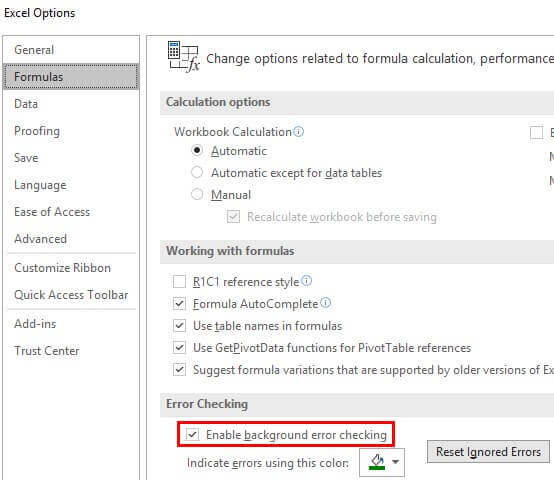

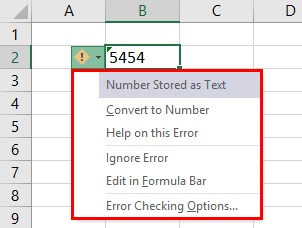
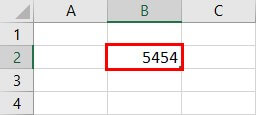
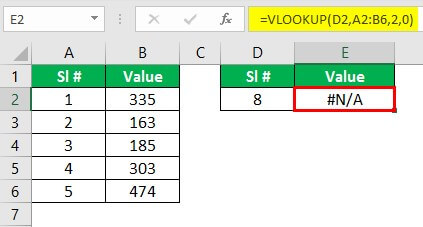
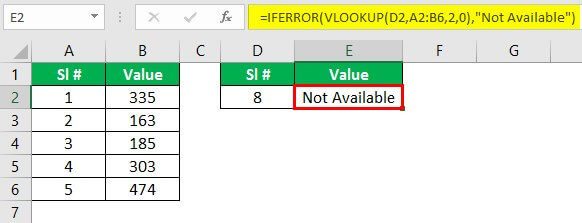



 > Excel Options > Formulas.
> Excel Options > Formulas.
 on the Quick Access Toolbar.
on the Quick Access Toolbar.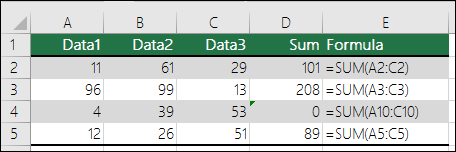
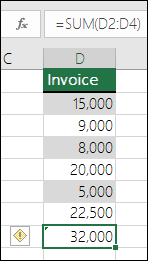
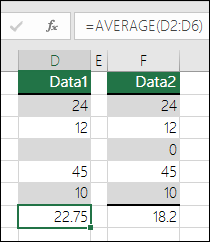

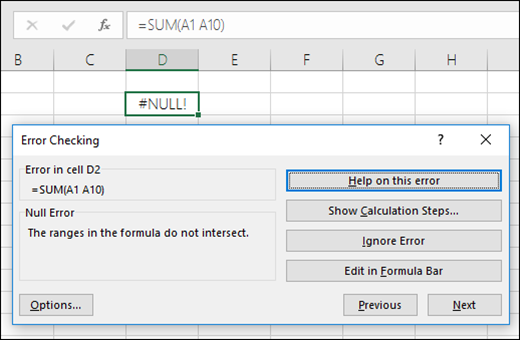
 that appears, and then click the option you want. The available commands differ for each type of error, and the first entry describes the error.
that appears, and then click the option you want. The available commands differ for each type of error, and the first entry describes the error.